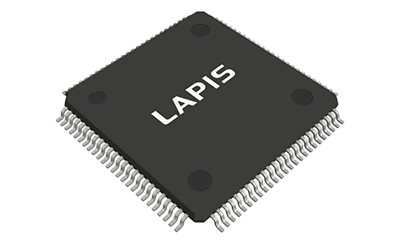What Is a 32-bit Microcontroller?

A 32-bit microcontroller is a microcontroller with a maximum instruction code bit width of 32 bits and a data bit width of 4 to 32 bits.
Microcontrollers are manufactured as semiconductor chips, and in addition to 32-bit microcontrollers, there are 4-bit, 8-bit, and 16-bit microcontrollers. 32-bit microcontrollers are at the highest level and have extremely high processing power.
Uses of 32-bit Microcontrollers
As evident in various home appliances that are labeled “microcontroller-equipped”, microcontrollers are utilized in a wide range of modern electrical products, including those used in industrial applications. LED displays that indicate operational states typically use 4-bit microcontrollers, while 8-bit microcontrollers are used for controlling white goods, and 16-bit microcontrollers are used in remote control products, depending on the required performance.
A 32-bit microcontroller, which has the highest level of processing performance, is used in situations where large amounts of data are processed at high speed or complex processing is performed at high speed, such as image processing for TVs and DVDs, data communications in communications equipment, engine control and driving control in automobiles, and image recognition and motion control in robots.
Principle of 32-bit Microcontrollers
Most 32-bit microcontrollers are equipped with not only standard peripheral circuits but also specialized processing circuits for specific applications, as complex and high-speed processing is required.
For example, applications related to image processing such as TV, DVD, and image recognition require a large number of sum-of-products operations. Since executing this operation in software requires a large number of steps and is extremely time-consuming, a dedicated circuit for high-speed processing in hardware is integrated to speed up the process.
In addition, for communication-related applications, a dedicated circuit called a UART that converts serial to parallel is used to process data that is mixed with various communication protocols.
Thus, 32-bit microcontrollers are also called system LSIs because they perform complex processing at high speed on a single chip by incorporating dedicated circuits for each application.
Today advances in semiconductor technology have made it possible to integrate one billion transistors on a single semiconductor chip. As a result, smartphones and other devices can integrate multiple dedicated circuits and CPU cores on a single chip and run user-developed applications, and the boundary between microcontrollers and processors is becoming blurred.
Other Information on 32-bit Microcontrollers
1. Characteristics of 32-bit Microcontrollers
32-bit microcontrollers are available in two types of instruction bit widths depending on the architecture of the Central Processing Unit (CPU): 32-bit fixed-length and 4~32-bit variable-length. Variable-length instructions are smaller in program size.
As the name “controller” implies, microcontrollers are used for controlling various devices and have limited applications compared to microprocessors found in servers, PCs, and other general-purpose applications.
Another difference between microcontrollers and microprocessors is the emphasis on real-time performance. To control devices, processing must be done on the fly, and the Operating Systems (OS) used in 32-bit microcontrollers are real-time OS that differ from the usual Windows OS. A typical real-time OS is the Japanese TCP/IP OS. A typical real-time OS is uITRON, a product of Japan’s TRON project.
In a 32-bit microcontroller, various timer/counter circuits, A/D converters, D/A converters, I/O port circuits, LCD driver circuits, memory circuits, etc. are integrated into the same semiconductor chip with a 32-bit CPU as the core.
2. About ARM Core
The core of a 32-bit microcontroller is the CPU core, which greatly influences processing performance and ease of use, of which the ARM core is the most representative.
The ARM core is the core of the microcontroller found in most smartphones and information appliances for both iOS and Android and was developed by ARM, a company founded in the UK in 1990. It is a CPU core with a fixed-length, concise instruction set architecture while also having the features of a variable-length instruction set. Its simple circuit structure makes it easy to apply to the progress of semiconductor miniaturization, and it is characterized by its low power consumption and high processing power.
Low power consumption is essential for mobile devices that require batteries and industrial devices that are in constant operation. The arrival of the IoT era, in which various objects are connected to the network, has accelerated the demand for microcontrollers with both low power consumption and high performance.
ARM cores were licensed at the architecture and circuit levels, and were introduced in many companies, especially for mobile PCs and smartphones, rapidly expanding their market share.